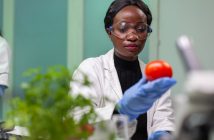CRISPR, the acronym for Clustered Regularly Interspaced Palindromic Repeats, is a collection of prokaryotic DNA sequences that solely serve as a cellular defence system. CRISPR/Cas systems are used by bacteria to sense and eliminate irregularities in DNA base pairs to protect DNA from bacteriophages. Its application to a myriad of gene sequences has led to the development of successful treatment strategies, especially for congenital and inheritable diseases. CRISPR food, in particular, is becoming increasingly popular, as scientists and farmers tap into the various advantages it offers.
In 2017, a groundbreaking report came in from the Broad Institute at the MIT and Harvard University stating the discovery of a new CRISPR/Cas system that cleaves DNA as well as RNA. Around the same time, the MIT Technology Review published reports of a CRISPR/Cas system that cleaves the minutest DNA fragments with ease and precision.

The range of spectacular results with CRISPR/Cas systems coming in from University research laboratories is immense. CRISPR’s rise stands apart from that of other genetic engineering tools owing to its accuracy, manoeuvrability and versatility with other genomes as well. Just a few weeks back, scientists at the Chinese Academy of Sciences altered gene sequences in pigs to produce what is being called as “CRISPR Bacon”. In fact, scientists at the Broad Institute call it “molecular scissors” useful for developing pest-resistant crops.
The scope of applying CRISPR to crops, poultry and other edibles isn’t unheard of; since 2015, CRISPR/Cas systems are being used for growing corn, wheat, tomatoes and culturing livestock with better dairy yield. No wonder CRISPR is being touted as the next big thing for food manufacturing companies.
Although the issue of genetic modification of foods has raised a tough battle between companies and regulatory bodies, CRISPR doesn’t seem to be facing much strife. This leads us to the question then, whether CRISPR is going to be the technology of choice for ensuring better food & nutrition for the world? Also, will CRISPR-based food be affordable enough for the most far-reaching consumers? Here are some insights which might lead us to some answers.
1. Using CRISPR for food production doesn’t require FDA approval
Yes, you heard that right. A letter from the US Department of Agriculture stated that mushrooms produced with CRISPR-based modifications reduced its browning tendencies with no external protein or antibody additions. This means CRISPR isn’t to do with modifying genes directly, rather only removing the parts that could be harmful. It doesn’t involve modifying gene sequences per se, which is why it doesn’t need strong vigilance the way GMOs used as foods did in the past. CRISPR based foods that are almost market-ready include cabbages with stronger long-staying flavours, tender red meat, drought-tolerant corn and non-browning mushrooms. Moreover, regular staples like rice, soy, potatoes, oranges and wheat are checked for possible genome modifications by CRISPR specialists. Agriculture experts reported that CRISPR can be applied to bigger plants and a wider range of crops than what was available before!
2. Eventually, the dairy industry can benefit from CRISPR
As research progresses swiftly on CRISPR/Cas systems, new Cas enzymes are being studied. Initially, Cas9 received glorious attention, soon after which scientists isolated Cas13 that cleaves RNA that is useful for repairing genomes with rare genetic diseases. Various probiotic foods using Cas enzymes in bacteria are being applied to enhance the protein content, shelf life and flavours of cheese and creamy yoghurts. Its utility in the preservation of active bacterial cultures used in the manufacture of dairy products is also being tested. The fact that CRISPR tools are faster and cheaper has got various food and dairy companies interested in implementing them. So it won’t be long before fortified cheese, milk and butter with zero spoilage arrive at the market, all thanks to CRISPR.
3. The primary advantage of using CRISPR is increasing the success of other GMO foods
The technology, although deemed controversial among bioethics experts, is a fascinating method for enhancing the marketability of other genetically modified foodstuffs. Earlier, edibles were checked for irregularities at RNA-protein levels and replaced with superior quality protein strands to increase product quality. Now, the site of repair is acted upon faster, it’s cleaved by CRISPR at the exact location and repaired much faster. So foods need not undergo enhancements with protein injections, instead, desirable alterations can be done before the early stages of growth itself. Plant breeding activities are undergoing massive changes with expert selection strategies, eliminating the need for R & D for systematic gene isolations, seed selections and breeding cycles. Now, genes that inhibit antibiotic resistance can be directly removed, weak genes prone to low protein expression can be repaired and pest-resistance can be conferred to plants with much simpler mechanisms.
4. CRISPR/Cas systems have been discovered specifically to enhance meat quality
CRISPR’s applicability is enormous, owing to its ability to cut open any organism’s genome. Touted to be a ‘molecular scalpel’ or ‘molecular scissors’, scientists have reported Cas enzymes for every kind of genetic enhancement possible. Today, there are Cas enzymes for engineering cord blood cells, immune cells, drug discovery, livestock breeding, fish culturing, etc. Not too long ago, FDA approved genetically modified salmon as safe to be eaten. The good news is that CRISPR-edited edibles are not transgenic organisms, hence they are not GMOs, they are gene-edited foods such as the CRISPR Bacon!
5. CRISPR has spurred the entry of biotech startups
News is that major pharma companies are investing heavily in this novel gene-editing technology. There have been big industry-academia collaborations happening between companies like DuPont Pioneer, Novartis, Monsanto, AstraZeneca and Wellcome Trust Sanger Institute, Innovative Genomics Initiative, the Broad and Whitehead Institutes in Massachusetts, and Thermo Fisher Scientific. These deals have initiated a surge in CRISPR’s already existing scope.
Some CRISPR pioneers have started off companies on their own, such as Editas Medicine by Feng Zhang and Caribou Biosciences by Emmanuelle Charpentier. Then in 2017, there were more start-ups particularly focussed on investigating Cas enzymes for genetic treatments, such as Crispr Therapeutics and Intellia Therapeutics.
CRISPR has already been through a long journey to make it through government regulations and environmentalists’ opinions. While CRISPR foods can be dismissed as trivial and frivolous by genome researchers, a tremendous amount of research is underway to produce CRISPR foods in days as compared to the months taken by farmers to harvest a fully utilizable GMO crop. The best part is that compared to GMO foods, gene-edited foods are actually cheaper to manufacture!
So, let’s just say that CRISPR’s role in food and agriculture has barely unfolded. A whole new arena of food science developments await and with that, a world devoid of malnourishment is just around the corner!








